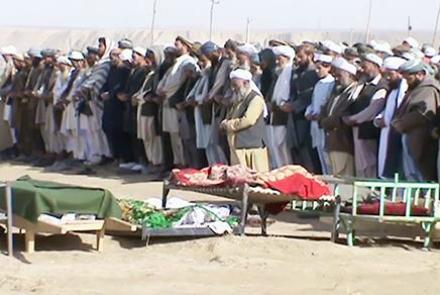A report by Afghanistan Independent Human Rights Commission (AIHRC) shows that 1,213 civilians were killed and 1,740 civilians were wounded in the first six months of this year, an 11% reduction from the same period in 2019.
The reduction comes amid increasing peace efforts by the Afghan government and its allies, but critics say violence is still high--especially by the Taliban--which is a key element of the peace process.
In 2019, the AIHRC findings showed that 979 civilians were killed and 2,359 others were wounded in the first six months of the year.
For the current period, the report says an average of 16 civilians a day became victims of violence in Afghanistan during this period, and blamed the Taliban for 48.5% of the casualties and Afghan forces for 15.5% percent.
The report blames “unknown perpetrators” for 26.7% of the casualties, Daesh for 6.3% and international forces for 2.3% of the civilian casualties in the first six months of this year.
The remaining percentage of civilian casualties, the report says, were caused by rocket shelling of Pakistani forces on Kunar, Kandahar, Paktia, and Khost provinces in eastern and southern Afghanistan.
The report states that 542 civilians were killed and 896 others were wounded in Taliban attacks during this period, which is a 24% decrease compared to the same period in 2019.
Civilian casualties in Taliban attacks in 2019 were 1,912 killed or wounded, the report highlights.
The report says the incident types included targeted killings (31% of casualties), IEDs (26%), rocket attacks (11.7%), ground battles (no percentage mentioned), airstrikes (killed 108 civilians) and nights raids (4 civilians killed).
The report says there was a 44 percent reduction in civilian casualties caused by airstrikes and 90% decrease in civilian casualties caused by night raids in the first six months of this year compared to the same period last year.
The AIHRC report indicates that the northwestern zone has endured the highest number of civilian casualties in the first six months of this year with 319 civilians killed and 373 others wounded.
The less affected areas were the western zone with 240 casualties (killed and wounded).
“All warring parties should leave violence and focus on negotiations,” AIHRC Deputy Chief Naeem Nazari said.
“Taliban and other terrorist groups in Afghanistan are the main cause of civilian casualties,” presidential spokesman Sediq Sediqqi said.
Victims families have often called for justice as two Kabul residents who lost their relatives in an attack early in March said the raid that happened on a gathering of politicians has yet to be probed.
“Such attacks show the weakness of the government,” said Suhaila Shujaee, a Kabul resident, referring to the March 7 attack on Afghan politicians gathering in the west of Kabul.
The report says there has been 0.5% reduction in women casualties in the first six months of this year compared to 2019. It shows that 126 women were killed and 171 others wounded during this period.
The report comes as five people were killed and 11 others wounded in a blast Surobi district, 60 kilometers east of Kabul.


